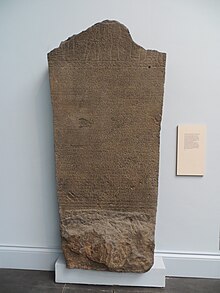Hamadab Stela
| Hamadab Stela | |
|---|---|
 Hamadab Stela | |
| Material | Sandstone |
| Size | 236.5 cm high, 101.5 cm wide |
| Writing | Meroitic |
| Created | 24 BC |
| Discovered | 1914 |
| Present location | British Museum, London |
| Registration | EA1650 |
The Hamadab Stela is a colossal sandstone stela found at
Discovery
The stela was found by the British archaeologist John Garstang in 1914 at the site of Hamadab, which is located a few kilometres south of Meroë, the capital of the ancient Kingdom of Kush. One of a pair, the excavators discovered the stelae either side of the main doorway into a small temple. As part of the division of finds, the stela to the left of the doorway was given to the British Museum, while the other was left in situ.
Description
The stela is in good condition, although part of the top is missing. The upper part includes a
Egyptian deities including Amun and Mut. Below this royal scene is a relief depicting bound prisoners
. A 42-line inscription in Meroitic cursive script is engraved beneath this.
Meroitic script
inscription, the names of the two monarchs Amanirenas and Akinidad are clearly discernible. It has been proposed that the Hamabad Stela may commemorate a Kushite raid on Roman Egypt in 24 BC. One outcome of these raids could have been the looting of the Meroë Head from a city in Lower Egypt
.
Gallery
-
Detail of inscription
References
- ^ "stela". British Museum. Retrieved 2018-02-28.
- ^ British Museum Highlights
Further reading
- N. Strudwick, Masterpieces of Ancient Egypt (London, British Museum Press, 2006)

